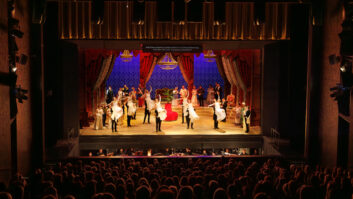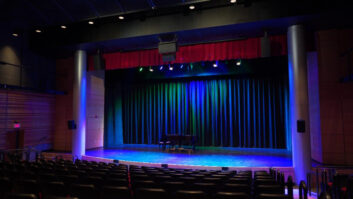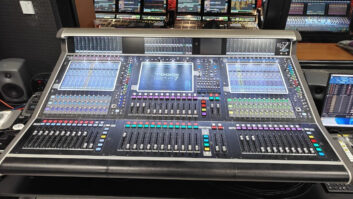 Created by Will Dean, the man behind Tough Mudder, and fellow fitness entrepreneur David Spindler, Electronic Theatre offers a slightly gentler experience than the renowned endurance event. What hasn’t changed, however, is the focus on teamwork and social interaction.
Created by Will Dean, the man behind Tough Mudder, and fellow fitness entrepreneur David Spindler, Electronic Theatre offers a slightly gentler experience than the renowned endurance event. What hasn’t changed, however, is the focus on teamwork and social interaction.
The idea for Electronic Theatre came about when Dean and Spindler were looking for their next project. This coincided with the beginnings of the ‘experiential economy’, with research showing that young people preferred to spend their money on experiences and creating memories, rather than on physical items. This, combined with a personal experience at a location-based VR concert, whereby the realisation came that these events tend to be solitary due to the use of headsets, led to the pair exploring this area in more detail.
Spindler explains: “Relatively quickly we came up with the idea that we could make something that is a group-based experience where technology doesn’t get in the way, and one where you can change up the content easily.”
A very basic prototype was created which consisted of a Microsoft Kinect camera taped to the ceiling and two players moving up and down playing a version of Pong in an industrial unit in North London. After testing the concept with friends and family, the idea of Electronic Theatre was born.
Opened on London’s Southbank in October, the first Electronic Theatre site consists of eight interactive digital rooms, or Light Boxes, utilising projection mapping, touch screens, motion tracking and surround sound technologies, which teams of up to six people enter to complete a number of interactive adventures in 30- or 60-minute sessions.
Key to the experience, and to the ability to make this a social event, is the fact that players don’t need to wear VR headsets or any other bulky equipment. A simple visor with an antenna on top to track players as they move around is all that’s required.
The current adventure, Alien Aptitude Test, includes retro-style computer games that offer physical and mental challenges accompanied by a high-energy 80s soundtrack delivered in surround sound. A PacMan-style game has players running around the room gathering coins while avoiding the ghost, while during a pairs-style card game challenge players have to identify matching cards as they move around the room. The latter adventure brings in the element of touchscreen interactivity.
Games are developed in house, meaning they can be rolled out on a regular basis; the aim is to have four or five new adventures developed for next year to keep the content fresh and to keep people coming back. Next up is Rescue the Royals, where teams are charged with rescuing the Queen, who has been locked in a castle in Scotland after Britain was sold to a US live streaming service.
Not surprisingly, technology is at the core of the experiences. The AV setup was designed by CTO Jan Breens, who has been working in the field of immersive experiences since 2007: “My background is in integrating large systems; I did planetariums for a long time. I then moved into VR, like so many people, and so now coming back out of VR into something projection based again it’s really nice to see and it’s great fun.”
When it came to the initial technical fit out, the team were clear that they didn’t want to have to invent anything new to achieve their aims. What wasn’t so clear was whether the end result would be scalable and result in a price point that people would find reasonable.
Which is where Breen comes in: “When I joined, there was a prototype, a vision for games that were fun and social, and the dimensions of the room. From there the challenge was finding the right technology to make it scalable and reliable.
“My approach is always to choose the best tool for the job, focusing on the places that are really important, like, for example, the tracking system – that just needs to be reliable and work and give the fidelity that is needed, whereas other things in the room can be a little more basic sometimes. It’s striking a balance between spending money in the right areas and still choosing equipment that can last the length of the unit and give us the control we need.
“One thing that’s really important, I think in a unit like this, especially one that we want to scale, is that it can be operated easily, and that’s one of the main constraints of choosing equipment.”
Spindler adds: “It’s about bringing the games off the walls and into the room. The idea is that if you’re with a group of friends the technology helps support you having a great night with your friends, it’s enabling that experience but you’re not having to plug into technology.”
And the visors help with this: “We needed somewhere to mount the trackers and it works well with the ’80s theme, they’re low maintenance, easy to clean and people seem to like them.”
The touchscreen technology has also been a hit: “It’s really surprised me in how simple it is,” says Breen. “I’ve done a lot of very big touch video walls and we couldn’t use any of that technology in this particular implementation because we have wall-to-wall projection so we can’t have a frame or anything like that. We use a very simple camera-based touchscreen system that added a whole dimension to every experience in a very simple manner.”
Looking ahead and a motion tracking system that can truly tell you where a person’s arms and legs are is very much on the wishlist. Breens explains: “Currently we track the core of the person as they move around, but really understanding where that person is, that’s a clear benefit to us. That would be a real gamechanger.”
There are also plans to add basic speech recognition to enable choose-your-own-adventure-type responses. Currently there’s a microphone in the rooms so it’s just a case of developing the software.
And plans for the future don’t stop there – the aim is to open 10-20 units next year in the UK, as well as the first units in the US. As Spindler explains: “That’s why it was important we were making choices a few months ago that will allow us to do that. It’s grand ambitions for sure but the plan is to have 1,000 units in five years.”
There is also an intention to extend the reach of the games, with adventures aimed at younger children to appeal to the family market; educational content is also in the pipeline where less popular time slots will be offered free at the point of use to schools and other educational groups. Look out for Macbeth the video game to help students with their English revision.







